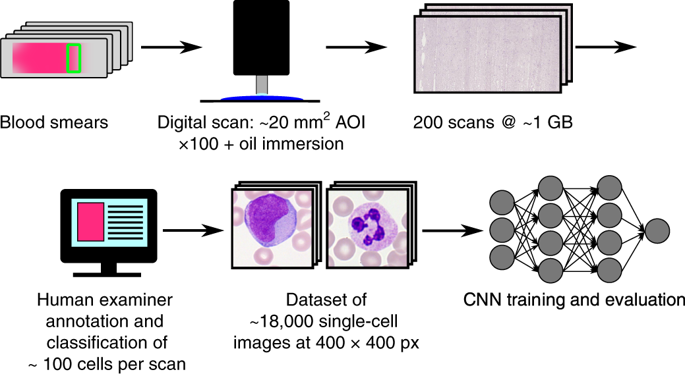Nature Machine Intelligence ( IF 23.8 ) Pub Date : 2019-11-12 , DOI: 10.1038/s42256-019-0101-9 Christian Matek , Simone Schwarz , Karsten Spiekermann , Carsten Marr

|
Reliable recognition of malignant white blood cells is a key step in the diagnosis of haematologic malignancies such as acute myeloid leukaemia. Microscopic morphological examination of blood cells is usually performed by trained human examiners, making the process tedious, time-consuming and hard to standardize. Here, we compile an annotated image dataset of over 18,000 white blood cells, use it to train a convolutional neural network for leukocyte classification and evaluate the network’s performance by comparing to inter- and intra-expert variability. The network classifies the most important cell types with high accuracy. It also allows us to decide two clinically relevant questions with human-level performance: (1) if a given cell has blast character and (2) if it belongs to the cell types normally present in non-pathological blood smears. Our approach holds the potential to be used as a classification aid for examining much larger numbers of cells in a smear than can usually be done by a human expert. This will allow clinicians to recognize malignant cell populations with lower prevalence at an earlier stage of the disease.
A preprint version of the article is available at bioRxiv.中文翻译:

卷积神经网络对人急性髓细胞白血病中胚细胞的人源性识别
恶性白细胞的可靠识别是诊断诸如急性髓性白血病的血液系统恶性肿瘤的关键步骤。血细胞的显微形态学检查通常是由训练有素的检查员进行的,这使过程繁琐,耗时且难以标准化。在这里,我们编译了一个带注释的图像数据集,其中包含超过18,000个白细胞,用它来训练卷积神经网络进行白细胞分类,并通过与专家之间和专家内部的差异进行比较来评估该网络的性能。网络可以对最重要的小区类型进行高精度分类。它也使我们能够决定两个与人类水平相关的临床相关问题:(1)给定细胞是否具有胚细胞特性;(2)它是否属于非病理性血液涂片中正常存在的细胞类型。我们的方法有潜力用作分类检查工具,以比人类专家通常检查的方法检查涂片中大量的细胞。这将使临床医生能够在疾病早期识别出患病率较低的恶性细胞群。
该文章的预印本可从bioRxiv获得。


























 京公网安备 11010802027423号
京公网安备 11010802027423号